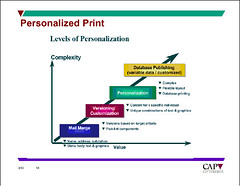Variable Data Book Printing (part one)
One of the great advantages digital book printers have over their ink & paper counterparts is the ability to print variable data books. Printing variable data books takes the limitation of digital presses to print long runs and turns it into an advantage—one for which the printer can charge more money. Digital presses can change images from one impression to the next while traditional presses are limited to printing the same image over and over again. In long print runs, the traditional press is superior (meaning less expensive to the publisher) because the set-up costs are spread over more copies of a book. At the same time, however, a traditional press cannot change images quickly because of the same set up costs which makes digital presses superior for variable data books.
There are several degrees of complexity for variable data books. Refer to the chart below.
The simplest level of complexity is to change one word or image within the book. This may include changing a logo or image on the cover of a book or customizing the interior of a set of books with a personalized message or selected name inserted within the text. Think of the analogy to a mail-merge letter. The body of the letter remains the same, but the name of the recipient changes from copy to copy.
The second degree of sophistication is versioning. Versions of the book are created based on target criteria. Book components change from version to version of the book. For instance, the cover for one version may be completely different for one version than it is for another.
The third degree of sophistication is personalization. Books have content for a specific individual. Each book has a unique combination of text and graphics.
The final degree of sophistication is database publishing, also known as variable data or customized book printing. This is a complex form of printing that creates a flexible layout based on input from a database.
I have printed books in each category, but I will say that versioning and mail merge printing is the most common. One book I printed for mail merge application was entitled “The Older Cat.” The print order was for 500 copies. The book had 20 contributors who supplied stories to the book. We were to print 480 copies without any customization, but add the contributor’s name to the cover of the final 20. I was present when the publisher gave the books to the contributors at the Book Expo of America. At first nobody noticed the personalization, but their eyes lit up when they saw their name on the cover. It was a gratifying sight to see.
I printed several version books. Two that come to mind are “A Christmas Dozen” and “Balanced Spirituality.” “A Christmas Dozen” was a best seller for the author. One Christmas, Shutters Hotel in Santa Monica ordered 200 copies of the book with their logo on the front cover to give to guests as a premium for staying with them over the holidays. We printed the 200 copies within a longer print run of 750 copies of the book. The publisher of “Balanced Spirituality” landed a contract with Albertson’s/Savon stores in Southern California. She requested that the cover of each book have either the Albertson’s or Savon logo on the back along with an inserted page in the front with a welcome message from Albertson’s/Savon’s president. We printed 500 of these books.
Personalized books are among the hardest to print. I printed over 1000 personalized books at Kinko’s for their annual “picnic.” Each member of the Operations and Sales team got a binder with their name on the front, a customized schedule of events based on their role within the company and a personalized set of meeting handouts.
We printed very few database driven books or publications. The closest we got was to print health care plan directories of doctors that varied by state and by type of plan.
Variable data books were very profitable for us. We were able to charge a 30% premium over our normal book price to print mail merge or versioned books. The change in cost to print the variable data books was minimal to us. The printing presses and pre-press computers did most of the work. There was increased quality control expense, as you can imagine, by inspecting each book in the print run. And if a mistake was made, it was expensive to reprint the incorrect book.
Variable data books were a product that I promoted heavily. They allowed me to differentiate myself from other book printers. In future posts, I will explore the challenges and opportunities in selling variable data books.


0 Comments:
Post a Comment
<< Home